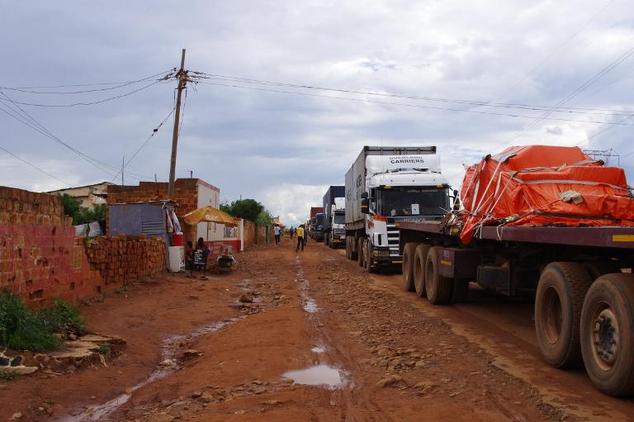Few African countries ratify tripartite FTA

Southern Times | 3 July 2017
Few African countries ratify tripartite FTA
By Jeff Kapembwa
Lusaka – A paltry eight African have so far ratified the Tripartite Free Trade Area (TFTA) more than two years after it was launched in Egypt, raising fears of a failed continental effort to create an expanded trade barrier free market.
On 10 June 2015 African leaders launched and signed the TFTA during a summit in the resort town of Sharma El Sheikh.
Countries that signed the TFTA included Angola, Burundi, Comoros, Democratic Republic of Congo, Djibouti, Egypt, Kenya, Malawi, Namibia, Rwanda, Seychelles, Sudan, Tanzania, Uganda and Swaziland while Zimbabwe and Zambia signed a week later.
The TFTA is espoused to enhance the harmonisation of infrastructure programmes and the development of common programmes for industrial and economic development among the 26 countries in Southern African Development Community (SADC), Common Market for Eastern and Southern Africa (Comesa) and the East African Community (EAC).
It is further projected to provide a broader market for over 650 million people with an anticipated Gross Domestic Product of over US$1.3 trillion per annum. The agreement, it was agreed by member states, would only come into effect once two-thirds of members ratified the agreement.
However, despite various countries appending their signatures to the agreement, there has been lukewarm responses towards ratifying, with Egypt, Rwanda, Seychel les, South Africa and South Sudan the only countries that have ratified.
Comesa’s secretary general Sindiso Ngwenya confirmed in an interview last week that only eight countries have ratified the TFTA while several were still undertaking formalities with respective authorities before ratifying.
“Yes, only eight have ratified the TFTA agreement and we are yet to receive the confirmation from other countries,” he said.
Zambia and Malawi, among others are yet to append their signatures.
Rwanda, Seychelles, South Africa and South Sudan are among other countries that have already ratified the TFTA, according to data.
But Ngwenya regrets the delays by members states over ratification fearing that most countries may have veered off course the ‘spirit’ under which they signed agreement. Many countries had actually pledged during the summit to expedite the ratification before the end of 2015 after finalising formalities from their respective parliaments. “The member states spoke in unison that they would all fulfill all formalities and ratify the TFTA before the end of 2015 or by mid 2016, but we have only seen a paltry eight ratifying it despite repeated reminders for them to hasten the process so that we can integrate as one Africa under a common market.”
He is, however, hopeful that despite the sluggish approach by most EAC, SADC and Comesa member states to append their signatures to the TFTA cause, the ongoing negotiations will help make the dream a reality before the end of this year noting that negotiations with various countries were going on well over the matter.
“Negotiations are going on and we hope by the end of this year all countries might have completed their negotiations and ratified the agreement to endorse the launch of the grand objective expected to broaden the market among member states under a trade barrier free environment.
Malawian Minister of Industry and Trade, Joseph Mwanamvekha, noted that while his country had not ratified the TFTA, negotiations with various interest groups had progressed and government recognised the essence of being part of the regional bloc.
“The TFTA is one of the best trade opportunities as trade will increase three to five times and more jobs will be created within the African bloc,” he is cited by local media.
Recently, Zambia’s Minister of Commerce Trade and Industry Margaret Mwanakatwe stated that various efforts had been made towards the realisation of the TFTA and steps had been made to consult Parliament to formalise various formalities that would allow the country to be part of the TFTA.
“We have made tremendous strides towards the TFTA but we are yet to finalise various instruments through parliament, but, we are almost there,” she added.
The TFTA was the brainchild of the Heads of State and Government from the regional economic communities and was mooted during their meeting in Kampala, Uganda, in October 2008 under a vision to see member countries work together towards the creation of an expanded market.
The idea was to be achieved through the establishment of a Tripartite Grand Free Trade Area as well as the harmonisation of infrastructure programmes and development of common programmes for industrial and economic development in the three blogs as a rider towards regional integration.
After the Kampala meeting, a series of negotiation rounds have been held since June 2011 until the launch of the TFTA. When operational, the TFTA will grant member states wider market access and create the largest free trade zone on the continent.
The three blocs; COMESA, EAC and SADC regions account for almost half of the African Union membership and about 60 percent of the continent’s GDP, which if TFTA is actualized, will ensure the vision of an economically integrated entity stretching from Cairo, Egypt to Cape Town, South Africa becoming a reality.
The launch of the TFTA was after a realisation that Africa has the lowest intra-continental trade, averaging 15 percent over the last decade. The TFTA realisation will serve as a catalyst to bolster intra- Africa trade and enable African economies to develop efficient synergies and linkages that are required to lift the export and manufacturing sectors.





